torque NISSAN TEANA 2008 Service Manual
[x] Cancel search | Manufacturer: NISSAN, Model Year: 2008, Model line: TEANA, Model: NISSAN TEANA 2008Pages: 5121, PDF Size: 69.03 MB
Page 901 of 5121
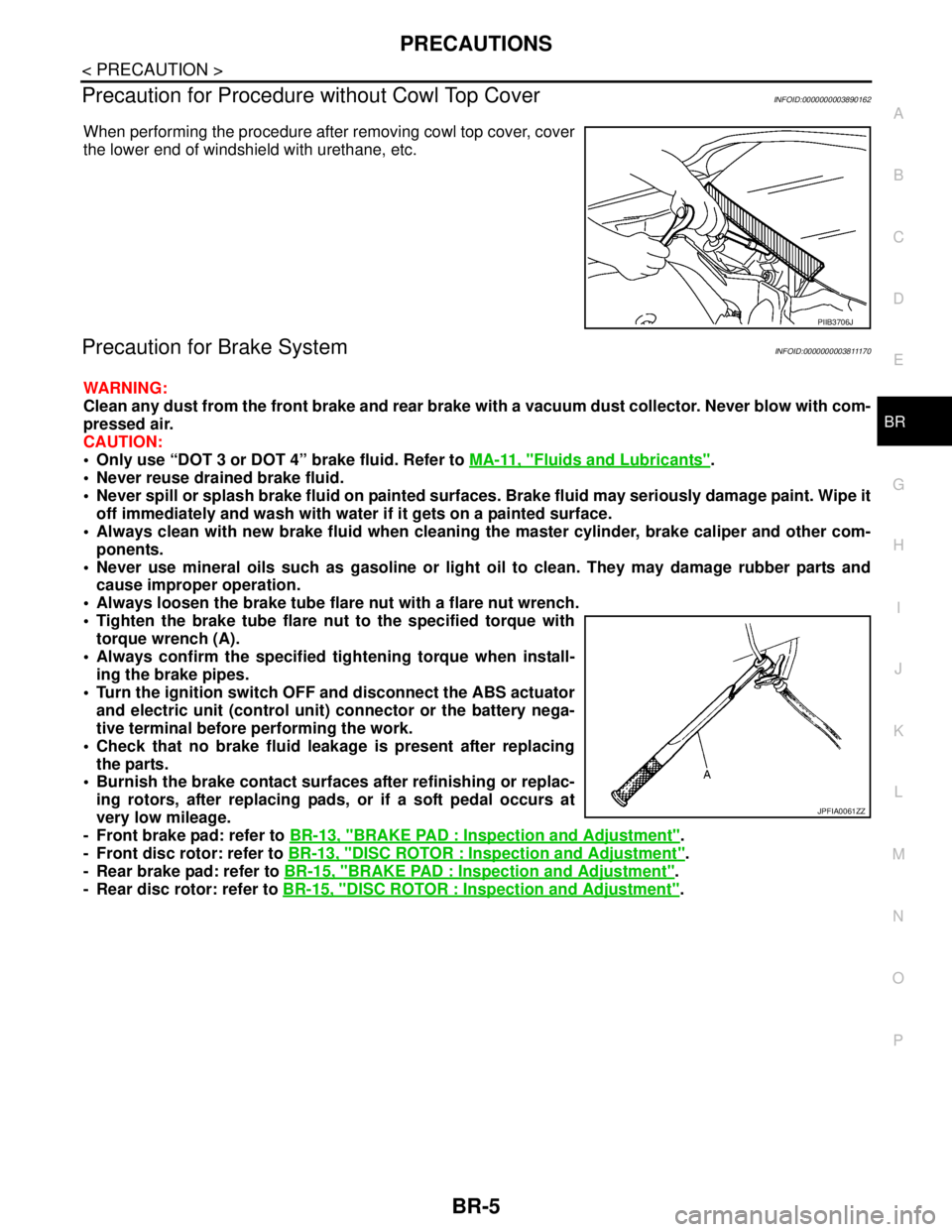
PRECAUTIONS
BR-5
< PRECAUTION >
C
D
E
G
H
I
J
K
L
MA
B
BR
N
O
P
Precaution for Procedure without Cowl Top CoverINFOID:0000000003890162
When performing the procedure after removing cowl top cover, cover
the lower end of windshield with urethane, etc.
Precaution for Brake SystemINFOID:0000000003811170
WARNING:
Clean any dust from the front brake and rear brake with a vacuum dust collector. Never blow with com-
pressed air.
CAUTION:
Only use “DOT 3 or DOT 4” brake fluid. Refer to MA-11, "
Fluids and Lubricants".
Never reuse drained brake fluid.
Never spill or splash brake fluid on painted surfaces. Brake fluid may seriously damage paint. Wipe it
off immediately and wash with water if it gets on a painted surface.
Always clean with new brake fluid when cleaning the master cylinder, brake caliper and other com-
ponents.
Never use mineral oils such as gasoline or light oil to clean. They may damage rubber parts and
cause improper operation.
Always loosen the brake tube flare nut with a flare nut wrench.
Tighten the brake tube flare nut to the specified torque with
torque wrench (A).
Always confirm the specified tightening torque when install-
ing the brake pipes.
Turn the ignition switch OFF and disconnect the ABS actuator
and electric unit (control unit) connector or the battery nega-
tive terminal before performing the work.
Check that no brake fluid leakage is present after replacing
the parts.
Burnish the brake contact surfaces after refinishing or replac-
ing rotors, after replacing pads, or if a soft pedal occurs at
very low mileage.
- Front brake pad: refer to BR-13, "
BRAKE PAD : Inspection and Adjustment".
- Front disc rotor: refer to BR-13, "
DISC ROTOR : Inspection and Adjustment".
- Rear brake pad: refer to BR-15, "
BRAKE PAD : Inspection and Adjustment".
- Rear disc rotor: refer to BR-15, "
DISC ROTOR : Inspection and Adjustment".
PIIB3706J
JPFIA0061ZZ
Page 906 of 5121
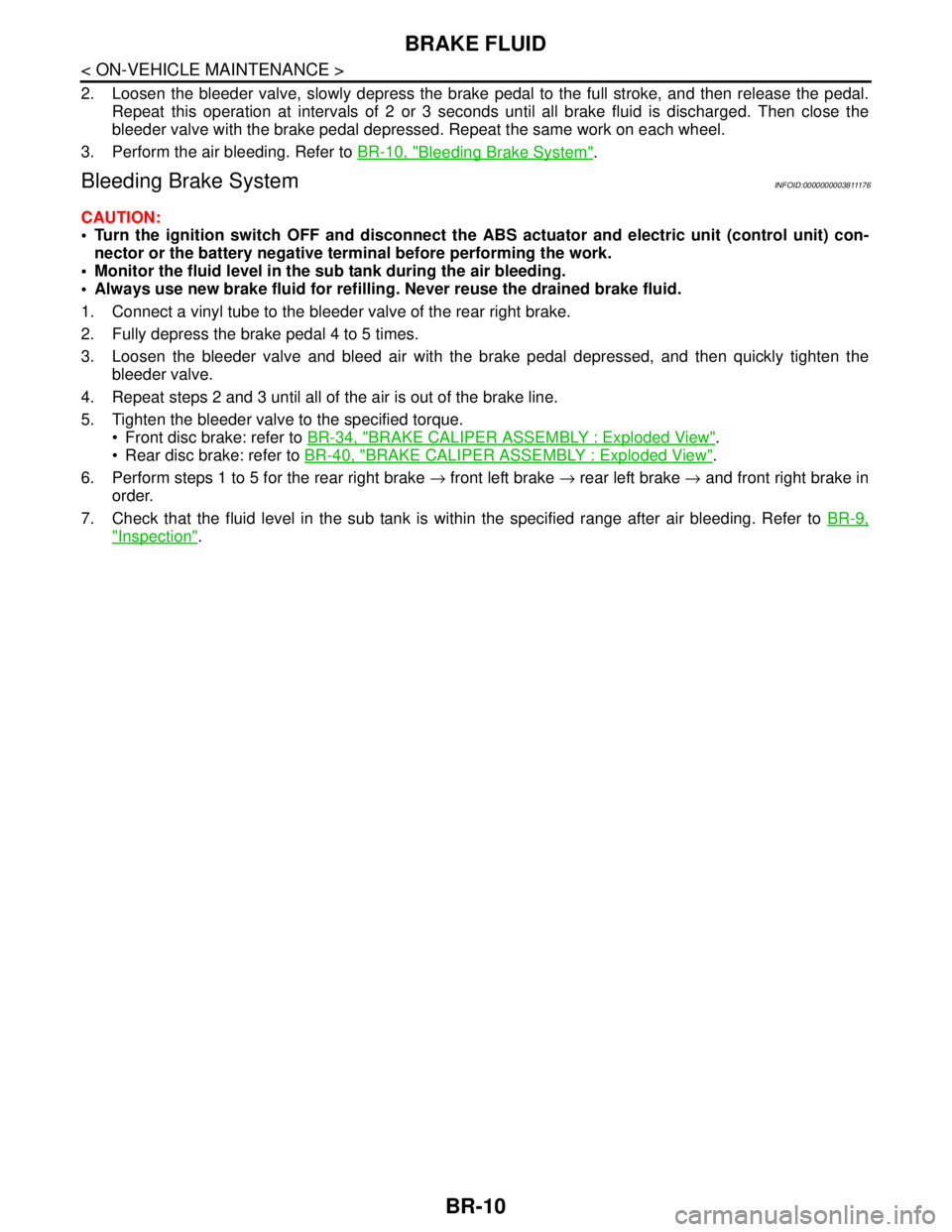
BR-10
< ON-VEHICLE MAINTENANCE >
BRAKE FLUID
2. Loosen the bleeder valve, slowly depress the brake pedal to the full stroke, and then release the pedal.
Repeat this operation at intervals of 2 or 3 seconds until all brake fluid is discharged. Then close the
bleeder valve with the brake pedal depressed. Repeat the same work on each wheel.
3. Perform the air bleeding. Refer to BR-10, "
Bleeding Brake System".
Bleeding Brake SystemINFOID:0000000003811176
CAUTION:
Turn the ignition switch OFF and disconnect the ABS actuator and electric unit (control unit) con-
nector or the battery negative terminal before performing the work.
Monitor the fluid level in the sub tank during the air bleeding.
Always use new brake fluid for refilling. Never reuse the drained brake fluid.
1. Connect a vinyl tube to the bleeder valve of the rear right brake.
2. Fully depress the brake pedal 4 to 5 times.
3. Loosen the bleeder valve and bleed air with the brake pedal depressed, and then quickly tighten the
bleeder valve.
4. Repeat steps 2 and 3 until all of the air is out of the brake line.
5. Tighten the bleeder valve to the specified torque.
Front disc brake: refer to BR-34, "
BRAKE CALIPER ASSEMBLY : Exploded View".
Rear disc brake: refer to BR-40, "
BRAKE CALIPER ASSEMBLY : Exploded View".
6. Perform steps 1 to 5 for the rear right brake → front left brake → rear left brake → and front right brake in
order.
7. Check that the fluid level in the sub tank is within the specified range after air bleeding. Refer to BR-9,
"Inspection".
Page 917 of 5121

BRAKE PIPINGBR-21
< ON-VEHICLE REPAIR >
C
DE
G H
I
J
K L
M A
B
BR
N
O P
FRONT : Removal and InstallationINFOID:0000000003811188
REMOVAL
CAUTION:
Never spill or splash brake fluid on painted surfaces. Brake fluid may seriously damage paint. Wipe it
off immediately and wash with wate r if it gets on a painted surface.
1. Remove tires.
2. Drain brake fluid. Refer to BR-9, "
Draining".
3. Loosen the flare nut with a flare nut wrenc h and separate the brake tube from the hose.
CAUTION:
Never scratch the flare nut and the brake tube.
Never bend sharply, twist or strong ly pull out the brake hoses and tubes.
Cover open end of brake tub es and hoses when disconnecting to prevent entrance of dirt.
4. Remove the union bolt and copper washers, and remove the brake hose from the brake caliper assembly.
5. Remove the lock plate and remove the brake hose.
INSTALLATION
CAUTION:
Never spill or splash brake fluid on painted surfaces. Brake fluid may seriously damage paint. Wipe it
off immediately and wash with wate r if it gets on a painted surface.
1. Assemble the union bolt and the copper washers to the brake hose. CAUTION:
Never reuse the copper washer.
2. Align the brake hose pin to the projection (A) of the brake caliper assembly and tighten the union bolt (1) to the specified torque.
3. Install the brake tube to the brake hose, temporarily tighten the flare nut by hand until it does not rotate further, and fix the brake
hose to the bracket with the lock plate.
CAUTION:
Check that all brake hoses and tubes are not twisted and
bent.
4. Tighten the flare nut to the specified torque with a crowfoot and torque wrench.
CAUTION:
Never scratch the flare nut and the brake tube.
5. Refill with new brake fluid and perform the air bleeding. Refer to BR-10, "
Bleeding Brake System".
CAUTION:
Never reuse drained brake fluid.
FRONT : InspectionINFOID:0000000003811189
INSPECTION AFTER INSTALLATION
1. Check the brake hoses and tubes for the following: no scratches; no twist and deformation; no interfer-
ence with other components when steering the steering wheel; no looseness at connections.
2. Depress the brake pedal with a force of 785N (80 kg, 177 lb) and hold down the pedal for approximately 5
seconds with the engine running. Check for any fluid leakage.
CAUTION:
Retighten the applicable connect ion to the specified torque and repair any abnormal (damaged,
worn or deformed) part if any brake fluid leakage is present.
1. ABS actuator and electric unit (con-
trol unit) 2. Front disc brake 3. Master cylinder assembly
4. Brake booster 5. Connector 6. Rear disc brake
A. Brake tube B. Brake hose : Flare nut
: Union bolt
JPFIA0099ZZ
Page 919 of 5121

BRAKE PIPINGBR-23
< ON-VEHICLE REPAIR >
C
DE
G H
I
J
K L
M A
B
BR
N
O P
REAR : Removal and InstallationINFOID:0000000003811192
REMOVAL
CAUTION:
Never spill or splash brake fluid on painted surfaces. Brake fluid may seriously damage paint. Wipe it
off immediately and wash with wate r if it gets on a painted surface.
1. Remove tires.
2. Drain brake fluid. Refer to BR-9, "
Draining".
3. Loosen the flare nut with a flare nut wrenc h and separate the brake tube from the hose.
CAUTION:
Never scratch the flare nut and the brake tube.
Never sharply bend, twist or strongly pull the brake hoses and tubes.
Cover the open end of brake tubes and hoses wh en disconnecting to prevent entrance of dirt.
4. Remove the union bolt and copper washers, and remove the brake hose from the brake caliper assembly.
5. Remove the lock plate and remove the brake hose from the vehicle.
INSTALLATION
CAUTION:
Never spill or splash brake fluid on painted surfaces. Brake fluid may seriously damage paint. Wipe it
off immediately and wash with wate r if it gets on a painted surface.
1. Assemble the union bolt and the copper washers to the brake hose. CAUTION:
Never reuse copper washer.
2. Install the brake hose L-pin by aligning it with the brake caliper assembly positioning hole, and tighten the union bolt (1) to the
specified torque.
3. Connect the hose to the brake tube, temporarily tighten the flare nut by hand until it does not rotate further, and fix the brake hose
to the bracket with the lock plate.
CAUTION:
Check that the brake hoses and tubes are not twisted and
bent.
4. Tighten the flare nut to the specified torque with a crowfoot and torque wrench.
CAUTION:
Never scratch the flare nut and the brake tube.
5. Refill with new brake fluid and perform the air bleeding. Refer to BR-10, "
Bleeding Brake System".
CAUTION:
Never reuse drained brake fluid.
REAR : InspectionINFOID:0000000003811193
INSPECTION AFTER INSTALLATION
1. Check the brake hoses and tubes for the following: no scratches; no twist and deformation; no interfer-
ence with other components when steering the steering wheel; no looseness at connections.
2. Depress the brake pedal with a force of 785N (80
kg, 177 lb) and hold down the pedal for approximately 5
seconds with the engine running. Check for any fluid leakage.
CAUTION:
1. ABS actuator and electric unit (con- trol unit) 2. Front disc brake 3. Master cylinder assembly
4. Brake booster 5. Connector 6. Rear disc brake
A. Brake tube B. Brake hose : Flare nut
: Union bolt
JPFIA0012ZZ
Page 920 of 5121

BR-24
< ON-VEHICLE REPAIR >
BRAKE PIPING
Retighten the applicable connection to the specified torque and repair any abnormal (damaged,
worn or deformed) part if any brake fluid leakage is present.
Page 922 of 5121
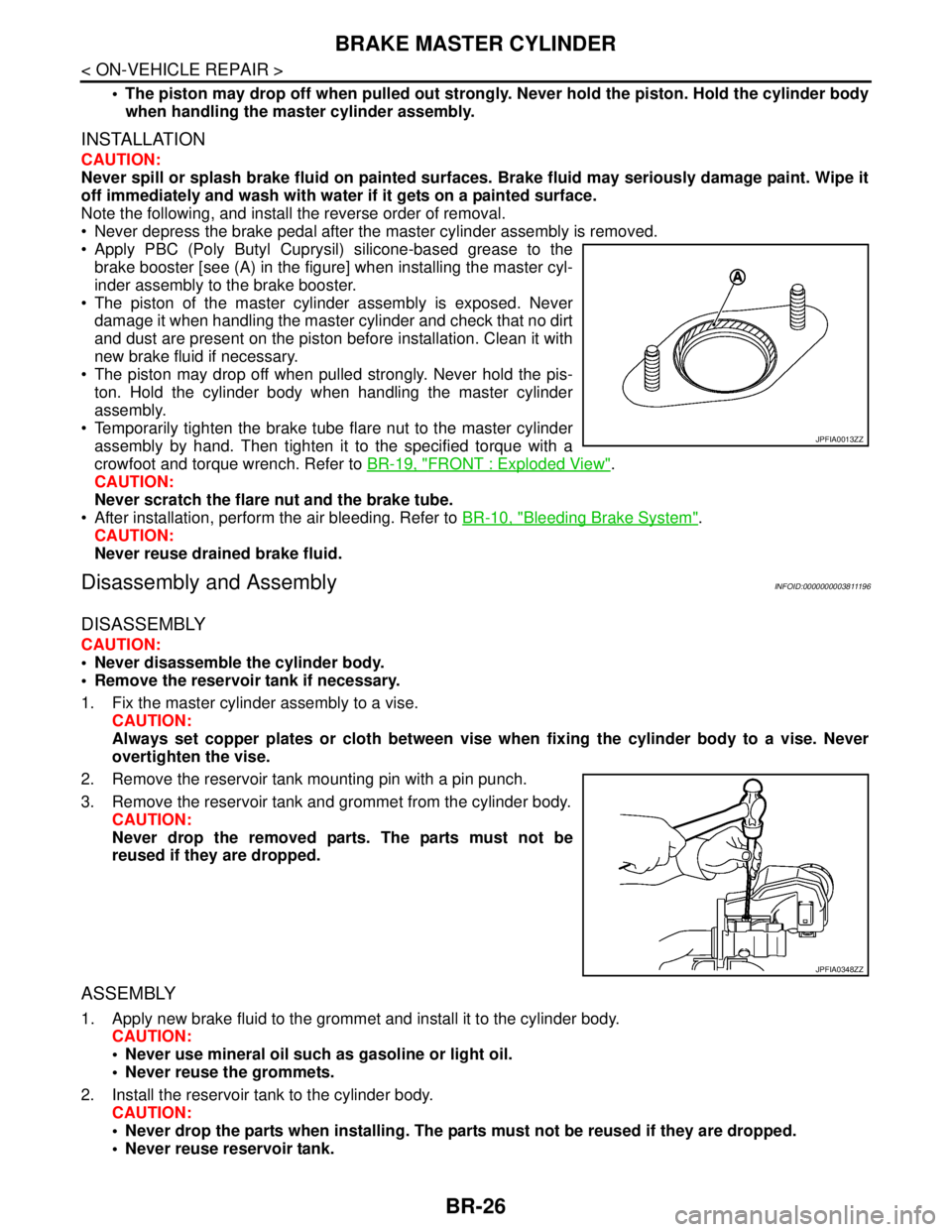
BR-26
< ON-VEHICLE REPAIR >
BRAKE MASTER CYLINDER
The piston may drop off when pulled out strongly. Never hold the piston. Hold the cylinder body
when handling the master cylinder assembly.
INSTALLATION
CAUTION:
Never spill or splash brake fluid on painted surfaces. Brake fluid may seriously damage paint. Wipe it
off immediately and wash with water if it gets on a painted surface.
Note the following, and install the reverse order of removal.
Never depress the brake pedal after the master cylinder assembly is removed.
Apply PBC (Poly Butyl Cuprysil) silicone-based grease to the
brake booster [see (A) in the figure] when installing the master cyl-
inder assembly to the brake booster.
The piston of the master cylinder assembly is exposed. Never
damage it when handling the master cylinder and check that no dirt
and dust are present on the piston before installation. Clean it with
new brake fluid if necessary.
The piston may drop off when pulled strongly. Never hold the pis-
ton. Hold the cylinder body when handling the master cylinder
assembly.
Temporarily tighten the brake tube flare nut to the master cylinder
assembly by hand. Then tighten it to the specified torque with a
crowfoot and torque wrench. Refer to BR-19, "
FRONT : Exploded View".
CAUTION:
Never scratch the flare nut and the brake tube.
After installation, perform the air bleeding. Refer to BR-10, "
Bleeding Brake System".
CAUTION:
Never reuse drained brake fluid.
Disassembly and AssemblyINFOID:0000000003811196
DISASSEMBLY
CAUTION:
Never disassemble the cylinder body.
Remove the reservoir tank if necessary.
1. Fix the master cylinder assembly to a vise.
CAUTION:
Always set copper plates or cloth between vise when fixing the cylinder body to a vise. Never
overtighten the vise.
2. Remove the reservoir tank mounting pin with a pin punch.
3. Remove the reservoir tank and grommet from the cylinder body.
CAUTION:
Never drop the removed parts. The parts must not be
reused if they are dropped.
ASSEMBLY
1. Apply new brake fluid to the grommet and install it to the cylinder body.
CAUTION:
Never use mineral oil such as gasoline or light oil.
Never reuse the grommets.
2. Install the reservoir tank to the cylinder body.
CAUTION:
Never drop the parts when installing. The parts must not be reused if they are dropped.
Never reuse reservoir tank.
JPFIA0013ZZ
JPFIA0348ZZ
Page 925 of 5121

BRAKE BOOSTER
BR-29
< ON-VEHICLE REPAIR >
C
D
E
G
H
I
J
K
L
MA
B
BR
N
O
P
Replace the clevis pin if it is damaged. Refer to BR-18, "Inspection and Adjustment".
After installation, perform the air bleeding. Refer to BR-10, "
Bleeding Brake System".
CAUTION:
Never reuse drained brake fluid.
Inspection and AdjustmentINFOID:0000000003811200
INSPECTION AFTER REMOVAL
Output Rod Length Inspection
1. With a handy vacuum pump, apply vacuum pressure of −66.7
kPa (−500 mmHg, −19.70 inHg, –0.667 bar) to the brake
booster.
2. Check the output rod length (A).
Input Rod Length Inspection
1. Loosen the lock nut (1) and adjust the input rod (2) to the speci-
fied length (B).
2. Tighten the lock nut to the specified torque.
INSPECTION AFTER INSTALLATION
Operation
Depress the brake pedal several times at 5-second intervals with the
engine stopped. Start the engine with the brake pedal fully
depressed. Check that the clearance between brake pedal and dash
lower pane decreases.
NOTE:
A slight impact with a small click may be felt on the pedal when the
brake pedal is fully depressed. This is a normal phenomenon due to
the brake system operation.
Air Tight
Standard
A: Refer to BR-45, "
Brake Booster".
JPFIA0021ZZ
Standard
B: Refer to BR-45, "
Brake Booster".
JPFIA0020ZZ
BRA0037D
Page 929 of 5121
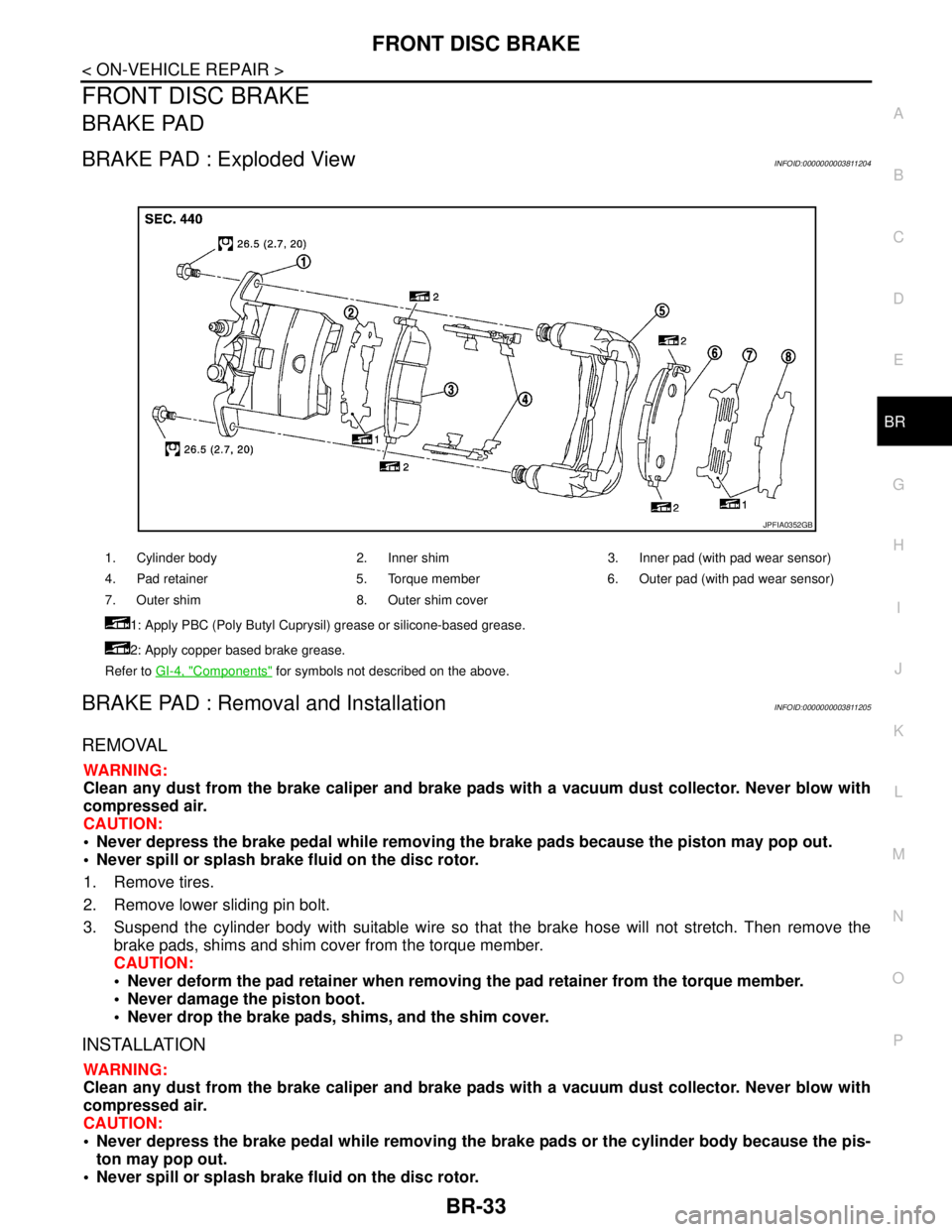
FRONT DISC BRAKE
BR-33
< ON-VEHICLE REPAIR >
C
D
E
G
H
I
J
K
L
MA
B
BR
N
O
P
FRONT DISC BRAKE
BRAKE PAD
BRAKE PAD : Exploded ViewINFOID:0000000003811204
BRAKE PAD : Removal and InstallationINFOID:0000000003811205
REMOVAL
WARNING:
Clean any dust from the brake caliper and brake pads with a vacuum dust collector. Never blow with
compressed air.
CAUTION:
Never depress the brake pedal while removing the brake pads because the piston may pop out.
Never spill or splash brake fluid on the disc rotor.
1. Remove tires.
2. Remove lower sliding pin bolt.
3. Suspend the cylinder body with suitable wire so that the brake hose will not stretch. Then remove the
brake pads, shims and shim cover from the torque member.
CAUTION:
Never deform the pad retainer when removing the pad retainer from the torque member.
Never damage the piston boot.
Never drop the brake pads, shims, and the shim cover.
INSTALLATION
WARNING:
Clean any dust from the brake caliper and brake pads with a vacuum dust collector. Never blow with
compressed air.
CAUTION:
Never depress the brake pedal while removing the brake pads or the cylinder body because the pis-
ton may pop out.
Never spill or splash brake fluid on the disc rotor.
1. Cylinder body 2. Inner shim 3. Inner pad (with pad wear sensor)
4. Pad retainer 5. Torque member 6. Outer pad (with pad wear sensor)
7. Outer shim 8. Outer shim cover
1: Apply PBC (Poly Butyl Cuprysil) grease or silicone-based grease.
2: Apply copper based brake grease.
Refer to GI-4, "
Components" for symbols not described on the above.
JPFIA0352GB
Page 930 of 5121
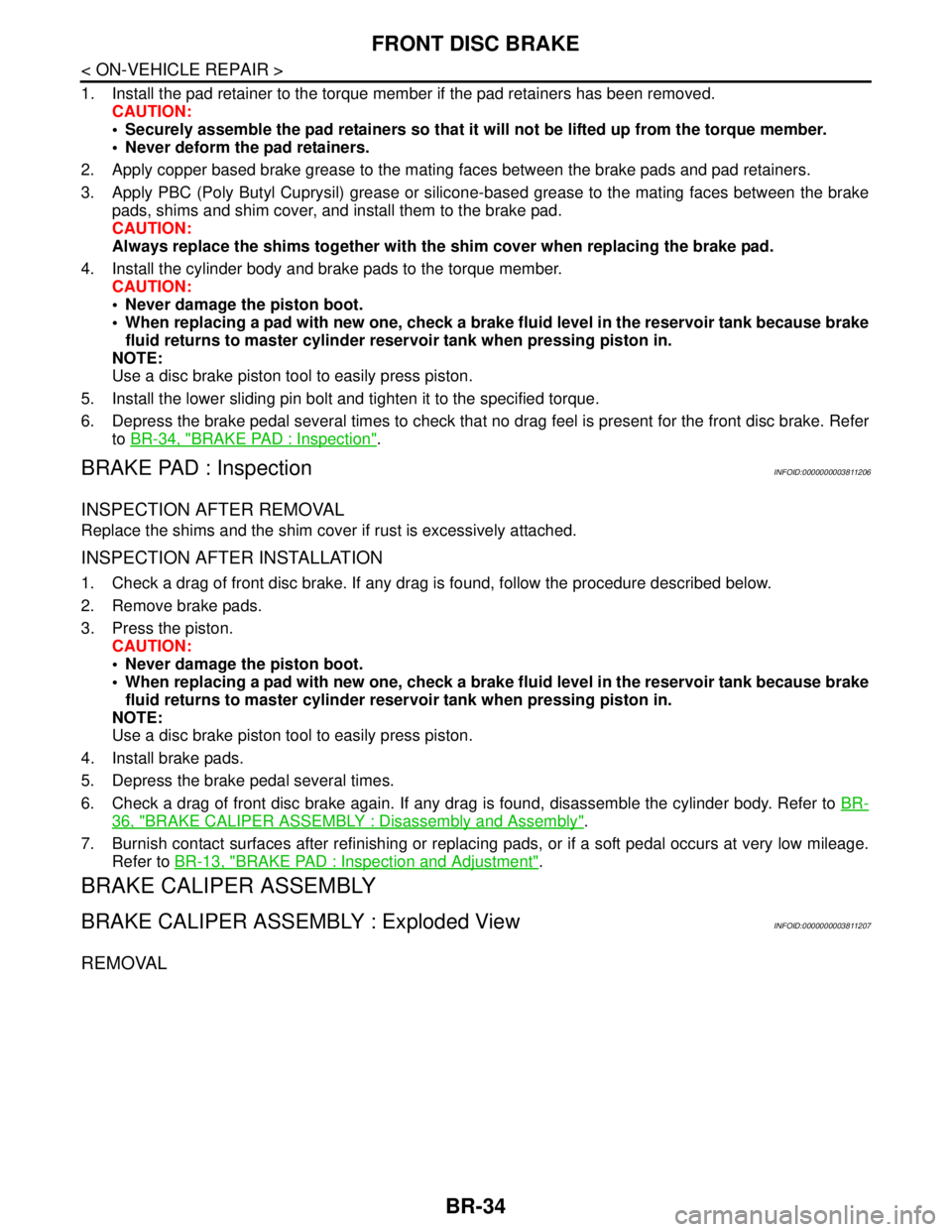
BR-34
< ON-VEHICLE REPAIR >
FRONT DISC BRAKE
1. Install the pad retainer to the torque member if the pad retainers has been removed.
CAUTION:
Securely assemble the pad retainers so that it will not be lifted up from the torque member.
Never deform the pad retainers.
2. Apply copper based brake grease to the mating faces between the brake pads and pad retainers.
3. Apply PBC (Poly Butyl Cuprysil) grease or silicone-based grease to the mating faces between the brake
pads, shims and shim cover, and install them to the brake pad.
CAUTION:
Always replace the shims together with the shim cover when replacing the brake pad.
4. Install the cylinder body and brake pads to the torque member.
CAUTION:
Never damage the piston boot.
When replacing a pad with new one, check a brake fluid level in the reservoir tank because brake
fluid returns to master cylinder reservoir tank when pressing piston in.
NOTE:
Use a disc brake piston tool to easily press piston.
5. Install the lower sliding pin bolt and tighten it to the specified torque.
6. Depress the brake pedal several times to check that no drag feel is present for the front disc brake. Refer
to BR-34, "
BRAKE PAD : Inspection".
BRAKE PAD : InspectionINFOID:0000000003811206
INSPECTION AFTER REMOVAL
Replace the shims and the shim cover if rust is excessively attached.
INSPECTION AFTER INSTALLATION
1. Check a drag of front disc brake. If any drag is found, follow the procedure described below.
2. Remove brake pads.
3. Press the piston.
CAUTION:
Never damage the piston boot.
When replacing a pad with new one, check a brake fluid level in the reservoir tank because brake
fluid returns to master cylinder reservoir tank when pressing piston in.
NOTE:
Use a disc brake piston tool to easily press piston.
4. Install brake pads.
5. Depress the brake pedal several times.
6. Check a drag of front disc brake again. If any drag is found, disassemble the cylinder body. Refer to BR-
36, "BRAKE CALIPER ASSEMBLY : Disassembly and Assembly".
7. Burnish contact surfaces after refinishing or replacing pads, or if a soft pedal occurs at very low mileage.
Refer to BR-13, "
BRAKE PAD : Inspection and Adjustment".
BRAKE CALIPER ASSEMBLY
BRAKE CALIPER ASSEMBLY : Exploded ViewINFOID:0000000003811207
REMOVAL
Page 931 of 5121
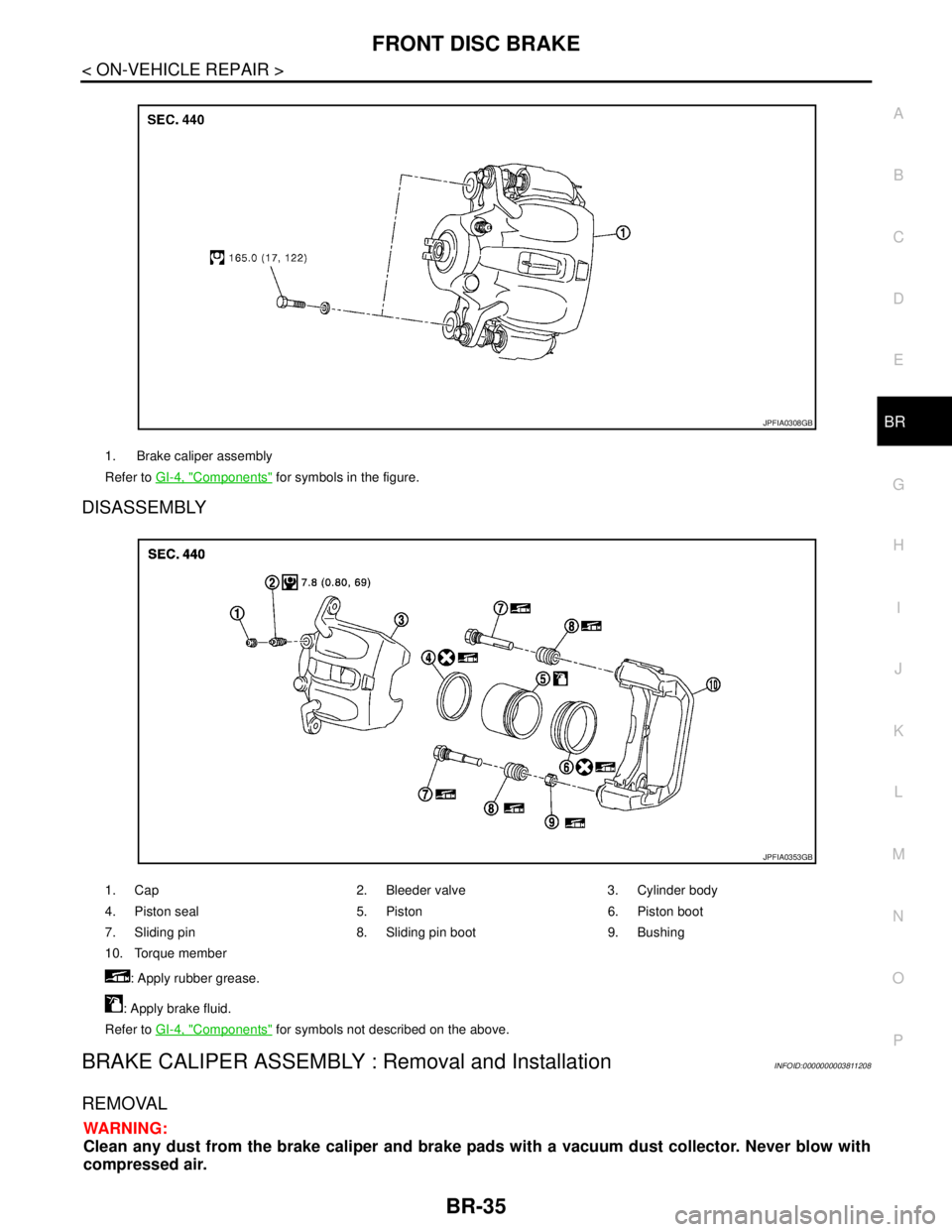
FRONT DISC BRAKE
BR-35
< ON-VEHICLE REPAIR >
C
D
E
G
H
I
J
K
L
MA
B
BR
N
O
P
DISASSEMBLY
BRAKE CALIPER ASSEMBLY : Removal and InstallationINFOID:0000000003811208
REMOVAL
WARNING:
Clean any dust from the brake caliper and brake pads with a vacuum dust collector. Never blow with
compressed air.
1. Brake caliper assembly
Refer to GI-4, "
Components" for symbols in the figure.
JPFIA0308GB
1. Cap 2. Bleeder valve 3. Cylinder body
4. Piston seal 5. Piston 6. Piston boot
7. Sliding pin 8. Sliding pin boot 9. Bushing
10. Torque member
: Apply rubber grease.
: Apply brake fluid.
Refer to GI-4, "
Components" for symbols not described on the above.
JPFIA0353GB